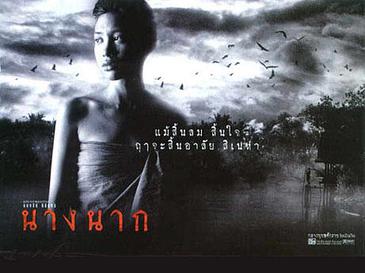
Was this an exhibition or a haunted mansion? That’s what most visitors must have thought as they descended into the darkness of the first room with voices whispering in the background and exhibits popping up like spectres in a funhouse.
The exhibition Spirits: Creativities from Beyond, which continues until January 9th at TCDC on the sixth floor of Bangkok’s Emporium, sheds light on the dark world of the supernatural in Asia, with displays of shaman’s robes, funeral offerings and rituals designed to ward off evil. The eeriest part is the room devoted to waxworks versions of Thai ghouls like the phi kraseu (a woman’s face atop dangling entrails that float through the air flashing on and off like a will ‘o’ the wisp) and phi pop (a flesh-eating zombie). These exhibits were combined with replicas of Ju-on (the crawling, grudge-bearing Japanese ghoul from the movie franchise) and even Count Dracula.
There is also a mannequin of Nang Nak, the most famous of all Thai phantasms. One story in Bizarre Thailand celebrates her legacy and examines why so many people come to pray at a shrine devoted this mass murderess on Sukhumvit Road.
As the most arch-conservative of all literary genres, horror has always traded on morality tales. Placards reveal the morals behind the mayhem. The phi krasue, for instance, or “filth ghost” is spread by saliva. Its hideous presence is a reminder that “cleanliness is next to godliness”. The phi pop, conversely, is a loner or social outcast. Though the exhibition doesn’t mention it, there was allegedly a real “ghost town” up in Chiang Dao more than a century ago, populated by villagers-cum-ghosts who had been shunned by their respective communities.
Spirits: Creativities from Beyond is a pan-Asian horror show. One section is devoted to funeral rites (nothing quite as ghastly as the last story in Bizarre Thailand) but that’s a small bone to pick. Many of the offerings for the dead, such as paper money and mobile phones, are burned by Chinese communities for their relatives to use in the Great Beyond. In spite of the effort of Taiwanese authorities to stop this practice, for fear it contributes to greenhouse gases, and in spite of their admonitions for relatives to donate the offerings on-line or give money to charities, the 6,000-strong Yue clan descended on their hometown outside Taipei last year to burn some 10 tons of paper offerings.
In unearthing the animistic roots of Japan, the exhibition presents viewers with a contemporary quandary: the Tamagotchi game, in which people nurture a mechanical pet, was founded on the animistic belief that all objects have a soul.
The exhibition zeroes in on the history of Thai comics, horror movies, and radio shows like the long-running “Shock FM” which must be the world’s only radio program entirely devoted to callers reciting ghost stories on air. (That story is also in “The Supernatural” section of the book.)
One of the most poignant elements is the tallying of expenses for funerals in Thailand: around 35 billion baht (more than US$3 billion) per year for the ceremonies, flowers, catering, souvenirs for mourners, caskets, etcetera. On the other palm, a survey undertaken by the Kasikorn Research Center revealed that the business of fortunetelling (including “offerings made to monks, astrological handbooks and activities to remove bad luck”) was worth almost 2.5 billion baht in the year 2008.
The exhibition does not shy away from taking a few pot shots at popular culture’s pantheon of money-raking ghosts. “When fear is entertainment, all the old beliefs in ghosts and spirits are cultural assets with the potential for big profits. New sound and image technology is scaring the money out of horror fans’ wallets both at home and abroad.”
But Spirits: Creativities from Beyond walks an almost invisible line between half-creepy, half-corny entertainment and confronting viewers with a fear of our own mortality that has haunted humankind for as long as these vengeful spectres and deathly rituals. As Stephen King observed in his memoir On Writing, “Horror stories are dress rehearsals for our own deaths.”
